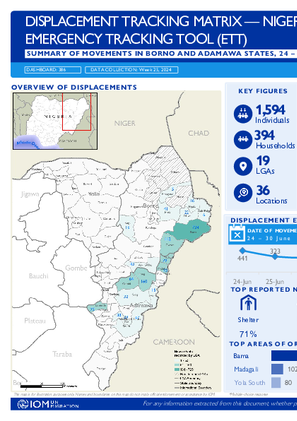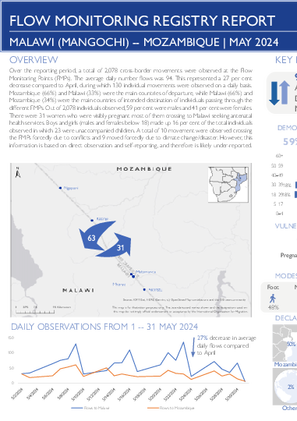-
Countries
-
Data and Analysis
-
Special Focus
-
Crisis Responses
Dashboard/Fact Sheet
Color
-

Contact
DTM Pakistan, DTMPakistan@iom.int
Language
English
Location
Pakistan
Period Covered
Jun 16 2024
Jun 30 2024
Activity
- Flow Monitoring
The International Organization for Migration (IOM) in Pakistan collects data on the outflows of Afghans at the Torkham (Khyber Pakhtunkhwa), Badini, Bahramcha and Chaman (Balochistan) border crossing points (BCPs) to better understand the movements of Afghans returning to Afghanistan. The data presented below is harmonised with those from the United Nations High Commissioner for Refugees (UNHCR), who also cover Ghulam Khan (Khyber Pakhtunkhwa).
On 26 September 2023, the Ministry of Interior in Pakistan announced its decision to enact its “Illegal Foreigners’ Repatriation Plan (IFRP)”. Between 16 and 30 June 2024, 15,149 Afghan nationals returned to Afghanistan, including 12,434 through the Torkham BCP, 2,580 through the Chaman BCP, 135 through the Ghulam Khan BCP, while no Afghan nationals returned through the Badini and Bahramcha BCPs. In addition, border authorities deported 342 individuals due to a lack of valid documentation. Since 1 January 2024, IOM identified 156,580 returns at the four BCPs.

Contact
iomnigeriadtm@iom.int
Language
English
Location
Nigeria
Period Covered
Jun 24 2024
Jun 30 2024
Activity
- Mobility Tracking
- Event Tracking
Between 24 and 30 June 2024, a total of 1,594 new arrivals were recorded at locations in Adamawa and Borno states. The new arrivals were recorded at locations in Askira/Uba, Bama, Dikwa, Gwoza, Kaga, Kala Balge, Mafa, Monguno and Ngala Local Government Areas (LGAs) of the most conflict-affected Borno State, and in Fufore, Gombi, Hong, Lamurde, Madagali, Maiha, Michika, Song, Yola North and Yola South LGAs of Adamawa State.
ETT assessments identified the following movement triggers: military operations (548 individuals or 34%), poor living conditions (377 individuals or 24%), improved security (315 individuals or 20%), seasonal farming (175 individuals or 11%), family re-unification (90 individuals or 6%), fear of attack (42 individuals or 2%), camp closure (31 individuals or 2%) and access to humanitarian support (16 individuals or 1%).

Contact
DTM Libya, DTMLibya@iom.int
Language
English
Location
Libya
Snapshot Date
Jun 30 2024
Activity
- Survey
- Flow Monitoring Survey
This document showcases the profile of construction migrant workers in Libya surveyed by DTM Libya in 2023. This profile highlights the main sociodemographic characteristics of migrant construction workers in Libya and their labour market conditions, such as the type of contract they hold and the main risks they face at work.

Contact
DTM Libya, DTMLibya@iom.int
Language
English
Location
Libya
Snapshot Date
Jun 30 2024
Activity
- Survey
- Flow Monitoring Survey
- Flow Monitoring
This document showcases the profile of agricultural migrant workers in Libya surveyed by DTM Libya in 2023. This profile highlights the main sociodemographic characteristics of migrant agricultural workers in Libya and their labour market conditions, such as the type of contract they hold and the main risks they face at work.

Contact
DTM Somalia, IOMSomaliaDTM@iom.int
Language
English
Location
Somalia
Period Covered
Jun 22 2024
Jun 26 2024
Activity
- Mobility Tracking
- Event Tracking
During this reporting period, DTM teams recorded 6,070 new arrivals across 511 settlements in the 15 districts DTM is operating in. Floods induced the majority of new displacements (75%), with the other main causes being conflict (15%), drought (7%), other causes (2%), and eviction (1%).

Contact
DTMAfghanistan@iom.int
Language
English
Location
Afghanistan
Period Covered
Jun 23 2024
Jun 29 2024
Activity
- Survey
- Flow Monitoring Survey
- Flow Monitoring
The IOM Afghanistan’s DTM Flow Monitoring activity is designed to provide insights into the mobility patterns at Afghanistan’s border points with the Islamic Republic of Iran and Pakistan. The activity involves two interlinked exercises: the Flow Monitoring Counting (FMC), a headcount of individuals crossing the border, and the Flow Monitoring Surveys (FMS), which collect data on the profiles and intentions of randomly selected Afghan nationals. DTM FM is operational at four main crossing points (connected to Afghanistan’s National Highway) as well as six other crossing points with Islamic Republic of Iran and Pakistan. This weekly snapshot combines information from the FM activity and various IOM sources related to cross-border movement. For a detailed explanation of the methodology used in gathering this data, the report directs readers to the section titled “IOM INFLOW DATA” on the last page.

Contact
DTM Burundi, DTMBurundi@iom.int
Language
English
Location
Burundi
Period Covered
Jun 17 2024
Jul 23 2024
Activity
- Mobility Tracking
- Event Tracking
La DTM Burundi a le plaisir de vous partager (dans le lien ci-dessus) des informations sur les urgences qui se sont produites au Burundi en dates du 17 au 23 juin 2024. La DTM a identifié 476 personnes affectées (95 ménages) dont 176 personnes déplacées (40 ménages) par les vents violents dans la province de Makamba.

Contact
ROPretoriaRMDHub@iom.int
Language
English
Location
Malawi
Period Covered
May 01 2024
May 31 2024
Activity
- Survey
- Flow Monitoring Survey
This report is an overview of the data collected from 1 to 31 May 2024 at Mangochi FMP in Malawi along the border with Mozambique and Karonga FMP in Malawi along the border with the United Republic of Tanzania. The Flow Monitoring Registry (FMR) collects data at Flow Monitoring Points (FMPs) through direct observation and interviews with key informants, including staff working at transit stations, border patrol officers, local authorities, bus or taxi drivers and travellers themselves. The FMR gathers data on the number of travellers crossing FMPs, as well as the provenance, next destination, vulnerabilities and means of transport of travellers.

Contact
DTM Libya, DTMLibya@iom.int
Language
English
Location
Libya
Period Covered
Jul 23 2024
Jul 29 2024
Activity
- Flow Monitoring
This fact sheet provides a bi-weekly update on migration-related events off the Libyan coast. During the reporting period, 226 migrants were intercepted and returned to Libya during the reporting period.

Contact
dtmuganda@iom.int
Language
English
Location
Uganda
Period Covered
Apr 20 2024
May 20 2024
Activity
- Flow Monitoring
IOM Uganda is pleased to share with you it’s the third Refugee Flow Monitoring report (FMR) for the period between 20 April to 20 May 2024 which is under the EU funded project aiming at “Strengthening Uganda’s national and sub-national institutions and systems to address the challenges of forced displacement and migration in Uganda”.
Over the reporting period, a total of 7,827 movements were observed at five Flow Monitoring Points (FMPs). These locations were chosen strategically as major transit points for monitoring movements in and out of Nakivale refugee settlement from the border between Uganda and the Democratic Republic of Congo through Nyakabande Transit Center.
More than half (69%) of the migrants at the Flow Monitoring Points self-declared as Congolese, Ugandans (20%), Burudian (5%), Rwandese (4%) and Others (2%).
The majority of movement from Nakivale refugee settlement were incoming flows (59%) against outgoing flows (41%). Forty-three per cent of the observed movements were refugees at the five Flow Monitoring Points. The means of transport mostly used were by foot (38%), motor bike & bike (31%), taxi or car (18%), truck (7%), bus (5%) and others (1%).
The majority of the flows were due to family reasons (20%), forced movement due to conflict (18%) and economic reasons (18%). Most of the movements were observed at the Nakivale check point FMP (32%) followed by Busanza (31%), Bunagana (17%), Nyakabande Transit Center (12%) and Rugaaga (8%). Among the migration flows, the most vulnerable groups were children under five (8%), pregnant and/lactating mother (7%) and the elderly (<1%).
Pagination
- Previous page
- Page 5
- Next page
